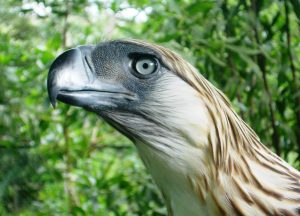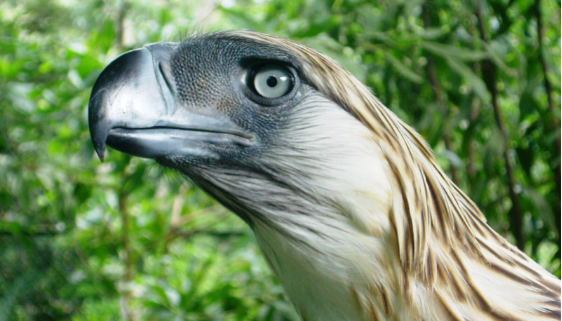
Every sexual organism is fathered by a single biological male parent. But for a Philippine Eagle, who celebrated its 28th “hatch-day” last Tuesday, January 15, three males helped bring this feathered critter into this world.
That eagle is Pag-asa (hope), the world’s first Philippine Eagle bred and hatched in captivity back in January 15, 1992 at the Philippine Eagle Center in Malagos, Davao City, and the three men, its (non-biological) parents, are Philippine Eagle Foundation’s Domingo “Doming” Tadena, Eddie Juntilla and Dennis Salvador.
Domingo Tadena
Regarded as one of the foundation’s pioneers, Doming was trained to help produce Pag-asa and 27 more eagles bred at the center. However, being the foundation’s senior conservation breeding biologist was everything but easy. Doming made it the hard way. Poverty forced him to quit school at a young age. To earn a living, he self-trained to be a carpenter and landed a contractual job at the old Philippine Eagle Rehabilitation facility in 1975 at Mt. Apo at the age of 27.
His thirst for learning and aspirations of a bright future motivated him to finish high school, then university with a Biology degree through a scholarship with the foundation.
From sweepers and hammers, he moved on to microscopes and incubators. In 1987, he apprenticed with the world’s top four raptor conservation institutions. He began in United Kingdom at the Jersey Wildlife Preservation Trust at Channel Islands and at the Royal College of Surgeons in London. There, he learned with experts on raptor conservation and medicine.
From UK, he flew to Canada at the McDonald Raptor Research Center, and after month, moved to the Peregrine Fund’s World Center for Birds of Prey in the USA, where he learned with experts on breeding and rearing endangered hawks and falcons. Together with colleague Eddie Juntilla, he returned to re-train with the Peregrine Fund before the breeding season of 1991. Back in the Philippines, he adapted what he learned overseas to the specific needs of the Philippine eagle.
Grit, creative labor and skill eventually paid off when he and his team hatched the first Philippine eagle bred in captivity on January 15, 1992.
Now 73, Doming trains a young generation of biologists and animal keepers who will continue on with the vocation. For Doming, helping Pag-asa get out of his egg is one of the happiest moments of his life. “I hope that someday, one of my young colleagues would eventually see a released captive eagle hatch its first young in the wild. That would be a very pretty sight”, he said.
Eddie Juntilla
Eddie, on the other hand, has been Pag-asa’s carer since day 1. He was 28 and was the team’s youngest animal keeper. Hatched inside an artificial incubator, Pag-asa has to be hand-fed and reared. Eddie played the role of a proxy parent.
Eddie had a university degree in Agriculture, with training in animal husbandry. He was theoretically prepared for the kind of work at the center but the actual job demanded more than technical skills. One must love the animal to keep up, and he has definitely a lot of it.
When Pag-asa became sexually mature, Eddie’s role changed to being a surrogate partner. Since then, he courts and socializes with Pag-asa 3 to 4 times a day for 5 straight months each year. This period is the breeding season, and Pag-asa is a semen-donor.
But to produce semen, the eagle must be adequately stimulated, and that is part of Eddie’s job – visit him, bond by offering fresh and leafy branches, and, once the bird showed excitement, solicit mating. Pag-asa mounting his protected shoulder or head and copulating is successful courtship.
Eddie, in turn, catches Pag-asa’s semen using his gloved hand and collects it into a syringe, which he then gives to a female eagle’s animal keeper. The semen is then injected to the cloaca of a receptive female by its human surrogate partner.
“Pag-asa is my ‘second wife’. And lucky me, although I spend more time with him, my real better half, Yolly, never gets jealous” he said in jest.
Apart from Pag-asa, Eddie is now surrogate partner to six more eagles at the center.
Dennis Salvador
Conserving one of the world’s most endangered raptor is a complicated and expensive endeavor. Someone has to do the task of making sure that money for staff training and salaries, equipment and operations is constantly available. Dennis played that very important role as the organization’s young executive director during Pag-asa’s hatching.
Prior to that time, the foundation was at the verge of closing shop. Dennis was food stock specialist during this crisis and keeping 11 eagles well fed and healthy was top priority. To keep them alive, including eagles Diola and Junior – Pag-asa’s biological parents – he and the rest of the staff had to give up their salaries.
Part of Dennis’ routine struggle was to bring food from the lowland to the remote breeding facility in Baracatan near Mt Apo. Live poultry and goats were manually hauled a few kilometers from where the road ends. This was in 1987 when roads were terrible.
Through Dennis’ strategic leadership and innovation skills, money and logistical support from generous partners came and saved the program.
However, the logistical challenges of maintaining a remote facility coupled by insurgency threats forced the relocation in July 1988 to its present site in Malagos.
Four years later, Pag-asa was born and became the sweet reward of their sacrifices.
“We gave Pag-asa his name because his birth truly lifted our spirits and motivated us to push forward. It also sends a strong message that for as long as Filipinos believe, we can give our national bird the chance to fly safe and free in our skies,” Dennis said.
Doming, Eddie and Dennis have dedicated their adult lives helping save Philippine eagles from being lost forever.
PEF staff and guests sang a “hatchday” song in front of Pag-asa’s cage last Tuesday, while the bird looked down from its perch. That day was also a celebration of the wonderful bond between three men and a Philippine Eagle and how their ties brought hope to Pag-asa’s imperiled kind. (By Jayson C. Ibanez, Philippine Eagle Foundation)

